It never really occurred to Deborah Chow that she was the first female “Star Wars” director until her first episode of “The Mandalorian” aired in 2019 and someone mentioned it to her.
“I was like, ‘Oh, wow,’” Chow recalls. “But I underestimated how big ‘The Mandalorian’ would be. I remember waking up when my episode came out and having a million texts and everybody telling me I’m trending on Twitter. I was kind of in shock.”
Chow’s success directing two episodes for the first season of “The Mandalorian” led to Lucasfilm hiring her to helm “Obi-Wan Kenobi,” a six-episode limited series that was originally imagined as a feature. The project, which was always intended as a vehicle for Ewan McGregor, had been in development for a while when Chow came on board, but she was instrumental in shaping the arc of the story alongside writer and showrunner Joby Harold.
“This one was really tricky, because we had a canon — we have a [‘Star Wars’] trilogy on both sides,” Chow says in an April conversation. “We also had a lot of legacy characters. It’s not just Obi-Wan, but we were trying to line up a lot of other characters. It was about trying to thread a needle, especially in Episode 6 to move into ‘A New Hope.’ We always knew there were going to be some inconsistencies here and there, but we were really trying as best we could to line up with the canon.”
Casting Ewan McGregor for “Obi-Wan Kenobi” was a given. But adding Hayden Christiansen was “special.”
(Matt Kennedy / Lucasfilm Ltd.)
Bringing back McGregor as Obi-Wan Kenobi was obviously central to the story, but Chow also wanted Hayden Christensen to return as Anakin/Darth Vader. “Getting to bring back Hayden and allowing him and giving him the space to come back to a character that was so important to him and that defines his life in so many ways, that was something honestly that felt really special.”
Once the series had its legacy cast in place, Chow worked to fill the rest of the world with equally memorable new characters, as well as a younger version of Princess Leia, played by Vivien Lyra Blair. Moses Ingram joined as Reva Sevander, a figure seemingly on the dark side with a complicated past, as did Indira Varma as Tala Durith.
“We wanted to have something new alongside the established characters,” Chow says. “But we also wanted to have more of a mixture and a little more diversity on the set. And getting to do a baby Princess Leia — she’s one of the most iconic female characters and having Carrie Fisher’s legacy to carry on — was amazing. The idea of seeing the formative years of how Leia became Leia, and trying to show some of what influenced her and how she became the woman that she goes on to be,” was an enticement to the project, Chow says.
“Obi-Wan Kenobi” was originally scheduled to shoot in London, but due to pandemic delays the production moved to Los Angeles in 2021. That move enabled Chow to use the StageCraft virtual technology employed by “The Mandalorian,” which was filming its second season on the same lot. Unlike “The Mandalorian,” which primarily shoots on a set known as “the Volume” — which projects the characters’ surroundings around the actors, rather than using green screen — Chow used a mixture of real locations, backlot sets and virtual sets. Each scene was mapped out in advance with concept art, previsualization and 3-D renderings. Ultimately, Chow wanted to ensure there was a balance between the visual and technical details and the emotion.
“I tried to have a real plan knowing that there’s a good chance a bunch of it will go out the window,” Chow notes. “You want to create enough room and enough space so that if something happens and there’s some magic on the set or an actor has an idea, there’s room for that. I want to have the ability to capture that stuff, especially emotionally, and to let them have the freedom.”

(Dominic Whisson / For The Times)
As with “The Mandalorian,” Chow drew on samurai films and westerns as inspiration. To create a memorable lightsaber battle between Obi-Wan and Darth Vader, the director looked to the martial arts movies she’d watched with her father, especially the work of Akira Kurosawa. But although the action sequences were exciting to shoot, Chow wanted to ensure that visual spectacle didn’t overshadow the narrative itself. As a series, “Obi-Wan Kenobi” reflects on such thematic ideas as power, sacrifice, grief and failure. What with all of the puppet creatures, Storm Trooper costumes and spaceships, Chow felt the show needed to be grounded in reality as much as possible.
“We talked a lot about ‘Does this work if you take the “Star Wars” out of it?’” Chow says. “Because at the end of the day, it’s about human emotions; it’s about human psychology. That was something we were quite conscious of. Coming out of ‘Revenge of the Sith,’ what George [Lucas] did was incredibly complex, and it was very psychological. The relationship between Vader or Anakin and Obi-Wan is incredibly complicated, so we tried to carry on with what [Lucas] started and see that relationship through.”
Chow, who directed on numerous TV shows before joining the “Star Wars” universe,” including “Mr. Robot” and “Better Call Saul,” is still looking for her next project following “Obi-Wan Kenobi.” The six episodes were executed as a limited series, with a purposeful conclusion, although Chow says “it’s not impossible that it couldn’t go on or there could be another story.” For now, though, she’s interested in exploring new worlds, whether they manifest on the small screen or the big screen.
“I went pretty quickly out of ‘The Mandalorian’ into this, so I actually didn’t have that much time to think about anything other than this,” Chow says. “It’s been almost five years in the ‘Star Wars’ canon between the two shows. I genuinely love genre and really love fantasy and sci-fi, so I really am always drawn to that material. But I like doing the emotional stuff and the character stuff, as well. Anything with that mixture is the ideal place for me. TV has changed hugely since I started working in it. The shows have gotten bigger, the budgets have gotten bigger, the material has gotten more interesting and that’s kept going. With a lot of the stuff I’m reading, I have no bias either way between features and TV. They’re both offering so much now.”

